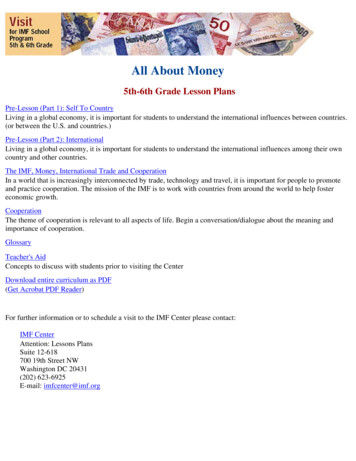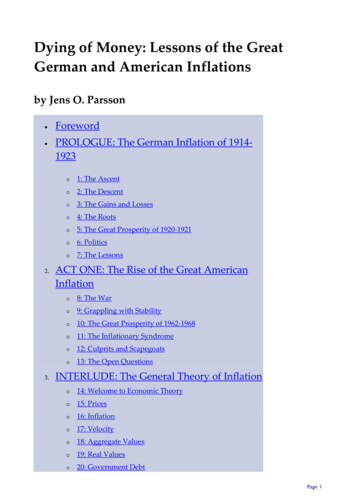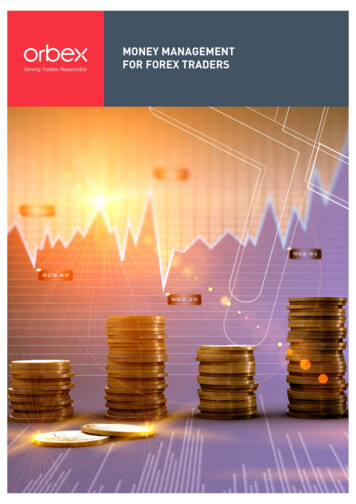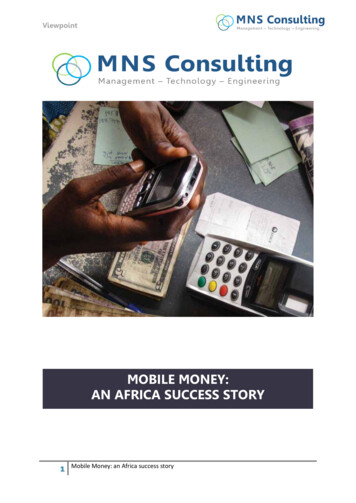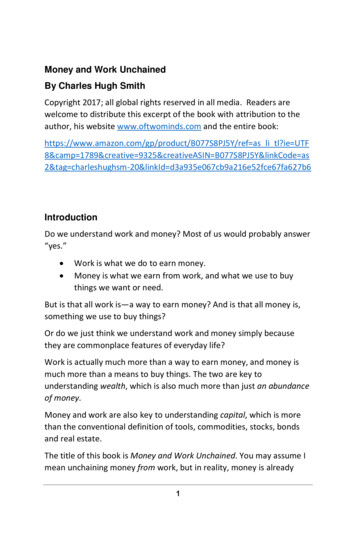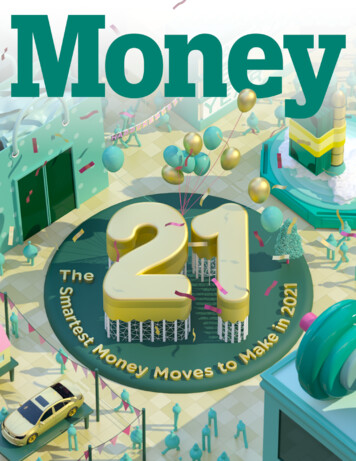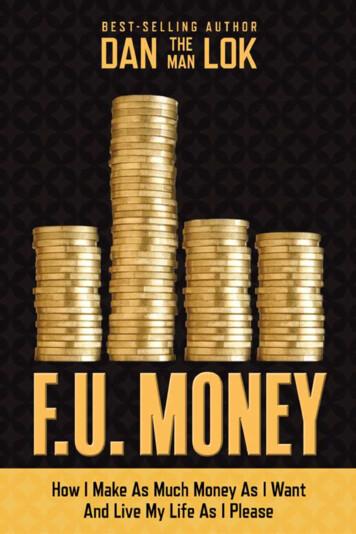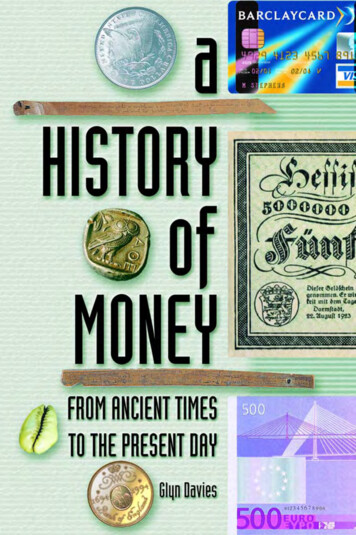
Transcription
A History of MoneyFrom Ancient Times to the Present Day
This page intentionally left blank
A History of MoneyFrom Ancient Times to the Present DayGLYN DAVIESPublished in co-operation withJulian Hodge Bank LimitedUNIVERSITY OF WALES PRESSCARDIFF2002
Glyn Davies, 2002First edition, 1994Reprinted, 1995Second edition, in paperback with revisions and Postcript, 1996Reprinted, 1997Third edition, with revisions, 2002All rights reserved. No part of this book may be reproduced, stored in aretrieval system, or transmitted, in any form or by any means, electronic,mechanical, photocopying, recording or otherwise, without clearance fromthe University of Wales Press, 10 Columbus Walk, Brigantine Place, CardiffCF10 4UP.www.wales.ac.uk/pressBritish Library Cataloguing in Publication DataA catalogue record for this book is available from the British LibraryISBN 0-7083-1773-1 hardbackISBN 0-7083-1717-0 paperbackThe right of Glyn Davies to be identified as author of this work has beenasserted by him in accordance with the Copyright, Design and Patents Act1988.Cover design by Neil James AngoveCover illustrations: Barclaycard reproduced with permission of BarclaysBank; tally sticks with permission of the Public Record Office; cowrie shelland ‘owl’ of Athens with permission of the Ancient Art & ArchitectureCollection; five million mark note with permission of Mary Evans PictureLibrary.Typeset in Wales at the University of Wales Press, CardiffPrinted and bound in Great Britain by Creative Print and Design, Ebbw Vale
ForewordFrom earliest times money in some form or another has been central toorganized living. Increasingly it shapes foreign and economic policies ofall governments. It is synonymous with power and it shapes history inevery generation.Professor Glyn Davies, Economic Adviser to the Julian Hodge BankLtd, and sometime Chief Economic Adviser to the Secretary of State forWales, and then to the Bank of Wales, is an ideal person to write thehistory of money itself. In his fifteen years as Sir Julian Hodge Professorof Banking and Finance at the University of Wales Institute of Scienceand Technology, Glyn Davies earned worldwide recognition as one ofthe United Kingdom’s front line economists. Both the CBI and variousSelect Committees of the House of Commons have sought his help.For over two decades there has been a unique partnership betweenWales’s financial wizard, Sir Julian Hodge, and Professor Glyn Davies.The genius of Sir Julian is matched by his intuitive caution in mattersfinancial: it is therefore a high tribute to Professor Glyn Davies that fortwo decades he has been Sir Julian Hodge’s trusted Economic Adviser.This book is a masterpiece of scholarly research which economistsand bankers will find invaluable. Professor Glyn Davies enjoys a raregift in being able to present the most complicated issues in clear andsimple terms.I declare my personal interest in this book because I have proved thequality of Professor Glyn’s work both when I served as Secretary ofState for Wales and when I was Chairman of the Bank of Wales.George TonypandyThe Right Honourable Viscount Tonypandy PC, DCL,House of Lords,Westminster1 March 1994
This page intentionally left blank
ToSir Julian Hodge LLDMerchant banker and philanthropist
This page intentionally left blank
ContentsForeword by George Thomas, The Right Honourable ViscountTonypandyDedicationAcknowledgementsPreface to the third editionvviixvxvii1 THE NATURE AND ORIGINS OF MONEY AND BARTER 1–331The importance of moneySovereignty of monetary policy3Unprecedented inflation of population5Barter: as old as the hills9Persistence of gift exchange11Money: barter’s disputed paternity13Modern barter and countertrading18Modern retail barter21Primitive money: definitions and early development23Economic origins and functions27The quality-to-quantity pendulum: a metatheory of money292 FROM PRIMITIVE AND ANCIENT MONEY TO THEINVENTION OF COINAGE, 3000–600 BCPre-metallic moneyThe ubiquitous cowrieFijian whales’ teeth and Yap stonesWampum: the favourite American-Indian moneyCattle: man’s first working-capital assetPre-coinage metallic moneyMoney and banking in MesopotamiaGirobanking in early Egypt34–653436373942454852
xCONTENTSCoin and cash in early ChinaCoinage and the change from primitive to modern economiesThe invention of coinage in Lydia and Ionian Greece5558613 THE DEVELOPMENT OF GREEK AND ROMANMONEY, 600 BC–AD 400The widening circulation of coinsLaurion silver and Athenian coinageGreek and metic private bankersThe Attic money standardBanking in DelosMacedonian money and hegemonyThe financial consequences of Alexander the GreatMoney and the rise of RomeRoman finance, Augustus to Aurelian, 14 BC–AD 275Diocletian and the world’s first budget, 284–305Finance from Constantine to the Fall of RomeThe nature of Graeco-Roman monetary expansion66–1126668717478798287941001061094 THE PENNY AND THE POUND IN MEDIEVALEUROPEAN MONEY, 410–1485Early Celtic coinageMoney in the Dark Ages: its disappearance and re-emergenceThe Canterbury, Sutton Hoo and Crondall findsFrom sceattas and stycas to Offa’s silver pennyThe Vikings and Anglo-Saxon recoinage cycles, 789–978Danegeld and heregeld, 978–1066The Norman Conquest and the Domesday Survey, 1066–1087The pound sterling to 1272Touchstones and trials of the PyxThe Treasury and the tallyThe Crusades: financial and fiscal effectsThe Black Death and the Hundred Years WarPoll taxes and the Peasants’ RevoltMoney and credit at the end of the Middle 71695 THE EXPANSION OF TRADE AND FINANCE,1485–1640What was new in the new era?176–237176
CONTENTSPrinting: a new alternative to mintingThe rise and fall of the world’s first paper moneyBullion’s dearth and plentyPotosi and the silver floodHenry VII: fiscal strength and sound money, 1485–1509The dissolution of the monasteriesThe Great DebasementRecoinage and after: Gresham’s Law in Action, 1560–1640The so-called price revolution of 1540–1640Usury: a just price for moneyBullionism and the quantity theory of moneyBanking still foreign to Britain?6 THE BIRTH AND EARLY GROWTH OF BRITISHBANKING, 1640–1789Bank money supply first begins to exceed coinageFrom the seizure of the mint to its mechanization, 1640–1672From the great recoinage to the death of Newton, 1696–1727The rise of the goldsmith-banker, 1633–1672Tally-money and the Stop of the ExchequerFoundation and early years of the Bank of EnglandThe national debt and the South Sea BubbleFinancial consequences of the Bubble ActFinancial developments in Scotland, 1695–1789The money supply and the 238–832382402452482522552632672722797 THE ASCENDANCY OF STERLING, 1789–1914284–366Gold versus paper . . . finding a successful compromise284Country banking and the industrial revolution to 1826286Currency, the bullionists and the inconvertible pound,1783–1826 293The Bank of England and the joint-stock banks, 1826–1850304The Banking Acts of 1826306The Bank Charter Act 1833309Currency School versus Banking School311The Bank Charter Act of 1844: rules plus discretion314Amalgamation, limited liability and the end of unit banking316The rise of working-class financial institutions323Friendly societies, unions, co-operatives and collecting societies 323The building societies327
xiiCONTENTSThe savings banks: TSB and POSBThe discount houses, the money market and the bill on LondonThe merchant banks, the capital market and overseas investmentThe final triumph of the full gold standard, 1850–1914Gold reserves, tallies and the constitution3333403453553658 BRITISH MONETARY DEVELOPMENT IN THETWENTIETH CENTURY367–456Introduction: a century of extremes367Financing the First World War, 1914–1918368The abortive struggle for a new gold standard, 1918–1931375Cheap money in recovery, war and reconstruction, 1931–1951384Inflation and the integration of an expanding monetary system,1951–1990397A general perspective on unprecedented inflation, 1934–1990397Keynesian ‘ratchets’ give a permanent lift to inflation399Filling the financial gaps405Stronger competition and weaker credit control408The American-led invasion and the Eurocurrency markets inLondon414The monetarist experiment, 1973–1990421The secondary banking crisis: causes and consequences421Supervising the financial system425Thatcher and the medium-term financial strategy431EMU: the end of the pound sterling?4439 AMERICAN MONETARY DEVELOPMENT SINCE 1700 457–548Introduction: the economic basis of the dollar457Colonial money: the swing from dearth to excess, 1700–1775458The official dollar and the growth of banking up to the CivilWar, 1775–1861466‘Continental’ debauchery466The constitution and the currency468The national debt and the bank wars471A banking free-for-all, 1833–1861479From the Civil War to the founding of the ‘Fed’, 1861–1913487Contrasts in financing the Civil War487Establishing the national financial framework490Bimetallism’s final fling494
xiiiCONTENTSFrom gold standard to central bank(s), 1900–1913The banks through boom and slump, 1914–1944The ‘Fed’ finds its feet, 1914–1928Feet of clay, 1928–1933Banking reformed and resilient, 1933–1944Bretton Woods: vision and realization, 1944–1991American banks abroadFrom accord to deregulation, 1951–1980Hazardous deposit insurance for thrifts, banks . . . andtaxpayersFrom unit banking . . . to balkanized bankingSummary and conclusion: from beads to banks without barriers49950450450951251752553053553954610 ASPECTS OF MONETARY DEVELOPMENT IN EUROPEAND JAPAN549–95Introduction: banking expertise shifts northward549The rise of Dutch finance550The importance of the Bank of Amsterdam550The Dutch tulip mania, 1634–1637551Other early public banks554France’s hesitant banking progress555German monetary development: from insignificance tocornerstone of the EMS567The monetary development of Japan since 1868582Introduction: the significance of banks in Japanesedevelopment582Westernization and adaption, 1868–1918583Depression, recovery and disaster, 1918–1948587Resurgence and financial supremacy, 1948–1990590Stagnation and the limitations of monetary policy, 1990–200259411 THIRD WORLD MONEY AND DEBT IN THETWENTIETH CENTURYIntroduction: Third World poverty in perspectiveStages in the drive for financial independenceStage 1: Laissez-faire and the Currency Board System,c.1880–1931Stage 2: The sterling area and the sterling balances,1931–1951596–641596601603607
xivCONTENTSStage 3: Independence, planning euphoria and bankingmania, 1951–1973Stage 4: Market realism and financial deepening, 1973–1993The Nigerian experienceImpact of the Shaw-McKinnon thesisContrasts in financial deepeningThird World debt and development: evolution of the crisisConclusion: reanchoring the runaway currencies61061661661962263263912 GLOBAL MONEY IN HISTORICAL PERSPECTIVELong-term swings in the quality/quantity pendulumThe military and developmental money-ratchetsFree trade in money in a global, cashless society?Independent multi-state central bankingConclusion: ‘Money is coined liberty’642–5964264664965265513 FURTHER TOWARDS A GLOBAL CURRENCY660–83The epoch-making euroMore coins in an increasingly cashless societyThe paradox of coin: rising production – falling significanceSpeculation and the Tobin TaxThe end of 2703–20
AcknowledgementsFirst and foremost I wish to thank Sir Julian Hodge for his unfailingsupport and encouragement. For over a quarter of a century I have beenfortunate in being able to observe at close quarters Sir Julian’s geniusfor making money – and for making money do good. As an economist Ihave particularly enjoyed the opportunities provided by suchexperiences to analyse how far abstract theories stand up incomparison with the practical tests of the market place. My gratefulthanks are also offered to Eric Hammonds, Chairman, and JonathanHodge, Director, Julian Hodge Bank Ltd., and to Venetia Farrell of theJane Hodge Foundation.To the late and sadly missed Viscount Tonypandy I remain greatlyindebted for his typically kind and prompt response in having writtenthe Foreword in his unique, incisive style.The academic sources on which I have drawn are widely spread overtime and space and include, for the more recent decades, colleagues andformer students. Only to a small degree can such debts be indicated inthe bibliography. To the many librarians who have made essentialmaterial easily and pleasantly available to me I am glad to record mythanks, especially to Ken Roberts of the University of Wales Library,Cardiff, and to my son Roy Davies, of Exeter University Library, whosemastery of the Web proved invaluable.The staff of the Royal Mint and scores of practising bankers, buildingsociety executives, accountants and civil servants who have generouslygiven of their time to discuss matters of financial interest similarlydeserve my gratitude.
xviACKNOWLEDGEMENTSMy warm thanks go to Ned Thomas, former Director of theUniversity of Wales Press, to his successor, Susan Jenkins, to RichardHoudmont, Deputy Director, to Liz Powell, Production and DesignManager, and to all the staff, including especially Ceinwen Jones,Editorial Manager, who have worked most expeditiously and withhighly commendable skill and zeal on my behalf. Despite suchenthusiastic professional assistance any errors remaining are my own.Finally, the long-suffering and devoted support of my wife, AnnaMargrethe, is beyond praise.
Preface to the Third EditionIn our technological age too many agree with Henry Ford’s bluntdictum that history is bunk, though he was far from thinking thatmoney was bunk. This ambivalent attitude remains prevalent today inthe general approach to economic and financial studies, so that whereasthere is a superabundance of books on present-day monetary andfinancial problems, politics and theories, it is my contention first thatmonetary histories are far too scarce and secondly that those which doexist tend in the main to be far too narrow in scope or period.Because of the difficulties of conducting ‘experiments’ in theordinary business of economic life, at the centre of which is money, it ismost fortunate that history not only generously provides us with apotentially plentiful proxy laboratory, a guidebook of more or lessrelevant alternatives, but also enables us to satisfy a natural curiosityabout the key role played by money, one of the oldest and mostwidespread of human institutions. Around the next corner there may belying in wait apparently quite novel monetary problems which in allprobability bear a basic similarity to those that have already beentackled with varying degrees of success or failure in other times andplaces. Yet despite the antiquity and ubiquity of money its propermanagement and control have eluded the rulers of most modern statespartly because they have ignored the wide-ranging lessons of the past orhave taken too blinkered and narrow a view of money.Economists, and especially monetarists, tend to overestimate thepurely economic, narrow and technical functions of money and haveplaced insufficient emphasis on its wider social, institutional andpsychological aspects. However, as is shown in this study, money
xviiiPREFACEoriginated very largely from non-economic causes: from tribute as wellas from trade, from blood-money and bride-money as well as frombarter, from ceremonial and religious rites as well as from commerce,from ostentatious ornamentation as well as from acting as the commondrudge between economic men. Even in modern circumstances moneystill yields powerfully important psychic returns (such as an individual’ssocial rank and standing or a nation’s position in the GNP leaguetable), while the eagerness to save or to spend is a fickle, moody,contagious, psychological characteristic, not fully captured in theeconomist’s statistics on velocity of circulation. Thus money, more thanever in our monetarist era, needs to be widely interpreted to includediscussion not only of currency and banking, but also savings banks,building societies, hire purchase finance companies and the fiscalframework on those not infrequent occasions when fiscal policyconflicts with or complements the operation of monetary policy. In thisregard it is demonstrated that even in medieval and earlier periods thesewider aspects were of considerably greater importance than isconventionally believed. There are therefore many advantages whichcan only be obtained by tracing monetary and financial history with abroad brush over the whole period of its long and convoluteddevelopment, where primitive and modern moneys have overlapped forcenturies and where the logical and chronological progressions haverarely followed strictly parallel paths.Anyone who attempts to cover such a wide range inevitably lays himor herself open to criticisms similar to those inescapably faced by mapmakers in attempting to portray the whole or a major part of the globeon a flat surface. If the directions are right the sizes of the variouscountries become grossly disproportional; attempts at equal areas begetother distortions in shape or direction; while the currently politicallycorrect Peters projection looks like nothing on earth. Similar criticismsrelate to the selection of historical material from the vast mass currentlyavailable. What some experts would regard as vitally important featuresmay have been glossed over or omitted, while other aspects which theymight consider trivial have been given undue attention. Selection fromsuch a vast menu is bound to be arbitrary, depending on the personaltaste of the author. Furthermore any claim to complete neutrality andunbiased objectivity is similarly bound to be untenable. Every list ofsins of commission or omission would vary, especially amongeconomists . . . six economists, at least half a dozen opinions.A further point: where one is dealing with a narrower, moremanageable period or area it is all the more possible (and highlyfashionable) to construct a sophisticated model or theory closely fitting
PREFACExixthe subject under scrutiny. Conversely, only the most loose-fitting (butnone the less useful) garment could possibly cover the variety of modelscomprising such a wide range as is examined in this book. One suchsimple theory does, however, emerge: the quality–quantity pendulum;although it must be borne in mind that its repetitional swings becomediscernible only where a long period of time is taken into consideration.The first three chapters look at primitive and ancient money and atthe origins of coined money and its development up to the fall of Rome.The next two chapters look at the unique disappearance and reemergence of coined money in medieval Britain, followed by the greatexpansion of trade and finance in Britain and Europe from around 1485to 1650. We then trace the development of British money and bankingto its dominant position in the gold standard system that eventuallybroke down in the period from 1914 to 1931, thereafter analysing themonetary controversies during the rest of the twentieth centuryincluding the implications of entry into the European MonetarySystem. The monetary development of the USA (in chapter 9) providesa considerable contrast, moving from wampum to world power in lessthat two centuries. Only a few of the salient features of money andbanking in parts of continental Europe and Japan are sketched inchapter 10 but with some emphasis being given to the closerrelationships seen in those countries between financial and industrialcompanies and the consequences that this might have for a faster rate ofeconomic growth than has occurred elsewhere. Chapter 11 deals withpre- and post-colonial monetary systems, the rise of indigenousbanking in the Third World and the vast problems of internationalindebtedness. Chapters 12 and 13 summarize progress towards apossible universal free market in money, including dollarization, therevolutionary advance of the euro and the controversial Tobin Tax.Henry Ford, the father of mass production, unconsciously gave theworld a powerful push towards the goal of global finance whereeventually the colour of everyone’s money will be the same. Fortunately,that blissful day has not quite yet dawned.1 June 2002
This page intentionally left blank
1The Nature and Origins of Moneyand BarterThe importance of moneyPerhaps the most common claim with regard to the importance ofmoney in our everyday life is the morally neutral if comicallyexaggerated claim that ‘money makes the world go round’. Equallyexaggerated but showing a deeper insight is the biblical warning that‘the love of money is the root of all evil’, neatly transformed by GeorgeBernard Shaw into the fear that it is rather the lack of money which isthe root of all evil. However, whether it is the love or conversely the lackof money which is potentially sinful, the purpose of the statement ineither case is to underline the overwhelming personal and moralsignificance of money to society in a way that gives a broader anddeeper insight into its importance than simply stressing its basicallyeconomic aspects, as when we say that ‘money makes the world goround’. Consequently whether we are speaking of money in simple, socalled primitive communities or in much more advanced, complex andsophisticated societies, it is not enough merely to examine the narroweconomic aspects of money in order to grasp its true meaning. Toanalyse the significance of money it must be broadly studied in thecontext of the particular society concerned. It is a matter for the heartas well as for the head: feelings are reasons, too.Money has always been associated in varying degrees of closenesswith religion, partly interpreted in modern times as the psychology ofhabits and attitudes, hopes, fears and expectations. Thus the tabooswhich circumscribe spending in primitive societies are basically notunlike the stock market bears which similarly reduce expendituresthrough changing subjective assessments of values and incomes, so that
2THE NATURE AND ORIGINS OF MONEY AND BARTERthe true interpretation of what money means to people requires thesympathetic understanding of the less obvious motivations as much as,if not more than, the narrow abstract calculations of the computer. Toconcentrate attention narrowly on ‘the pound in your pocket’ is todevalue the all-pervading significance of money.Personal attitudes to money vary from the disdain of a smallminority to the total preoccupation of a similarly small minority at theother extreme. The first group paradoxically includes a few of the veryrich and of the very poor. Sectors of both are unconsciously united inbelittling its significance: the rich man either because he delegates suchmundane matters to his servants or because the fruits of compoundinterest exceed his appetite, however large; the poor man because hemakes a virtue out of his dire necessity and learns to live as best he canwith the very little money that comes his way, so that his practicalrealism makes his enforced self-denial appear almost saintly. He limitshis ambition to his purse, present and future, so that his accepted wayof life limits his demand for money rather than, as with most of us, theother way round. At the other extreme, preoccupation with moneybecomes an end in itself rather than the means of achieving other goalsin life.Virtue and poverty, however, are not necessarily any more closelyrelated than are riches and immorality. Thus Boswell quotes SamuelJohnson:When I was a very poor fellow I was a great arguer for the advantages ofpoverty . . . but in a civilised society personal merit will not serve you somuch as money will. Sir, you may make the experiment. Go into the street,and give one man a lecture on morality, and another a shilling, and seewhich will respect you most . . . Ceteris paribus, he who is rich in a civilisedsociety, must be happier than he who is poor. (Boswell 1791, 52–3)Johnson’s commonsense approach to the human significance of moneynot only rings as true today as it did two centuries ago, but may bemirrored in the statements and actions of much earlier civilizations.The minority who find it possible to exhibit a Spartan disdain formoney has always been exceptionally small and in modern times hasdeclined to negligible proportions, since the very few people concernedare surrounded by the vast majority for whom money plays a role ofgrowing importance. Even those who as individuals might choose tobelittle money find themselves constrained at the very least to take intoaccount the habits, views and attitudes of everyone else. In short, nofree man can afford the luxury of ignoring money, a universal factwhich explains why Spartan arrogance was achieved at the cost of an
THE NATURE AND ORIGINS OF MONEY AND BARTER3iron discipline that contrasted with the freedom of citizens of otherstates more liberal with money. This underlying principle of freedom ofchoice which is conferred on those with money became explicitly partof the strong foundations of classical economic theory in the nineteenthcentury, expounded most clearly in the works of Alfred Marshall, as‘the sovereignty of the consumer’, a concept which despite all thequalifications which modify it today, nevertheless still exerts itsconsiderable force through the mechanism of money.Sovereignty of monetary policyThis essential linkage between money, free consumer choice andpolitical liberty is the central and powerful theme of Milton Friedman’sbrand of monetarism consistently proclaimed for at least two decades,from his Capitalism and Freedom (1962) to what he has called his‘personal statement’, Free to Choose, published in 1980. An even longercrusade championing the essential liberalism of money-based allocativesystems was waged by Friedrich Hayek, from his Road to Serfdom in1944 to his Economic Freedom of 1991.Yet for a generation before Friedman, the eminent Cambridgeeconomist Joan Robinson called into question the conventional basis ofconsumer sovereignty in her pioneering work on Imperfect Competition(1933). Indeed she doubted ‘the validity of the whole supply-anddemand-curve analysis’ (p.327). Many years later, with perhaps toohumble and pessimistic an assessment of the tremendous influence ofher writing, she felt forced to lament: ‘All this had no effect. Perfectcompetition, supply and demand, consumer’s sovereignty and marginalproducts still reign supreme in orthodox teaching. Let us hope that anew generation of students, after forty years, will find in this book whatI intended to mean by it’ (1963, xi).By the mid-1970s it became obvious that, as in the inter-war period,the fundamental beliefs of economic theory were again beingchallenged, and nowhere was this probing deeper or more urgent thanwith regard to monetary economics. Mass unemployment had pushedKeynes towards a general theory which, when widely accepted, helpedto bring full employment, surely the richest reward that can ever be laidto the credit (if admittedly only in part) of the economist’s theorizing.But persistent inflation posed questions which Keynesians failed toanswer satisfactorily, while the return of mass unemployment combinedwith still higher inflation finally destroyed the Keynesian consensus,and allowed the monetarists to capture the minds of our politicalmasters.
4THE NATURE AND ORIGINS OF MONEY AND BARTERNevertheless, Joan Robinson’s view is quite true in that themodifications of classical value theory (now being painfully andpatchily refurbished by the New Classical School) were as nothingcompared with the surging revolutions in monetary theories which haveoccurred since the 1930s, mainly taking the form of a forty years’ warbetween Keynesians and monetarists, until the latter ultimatelyachieved control over practical policies in much of the western world bythe end of the 1970s, despite the continuing strong dissent of the nowconventional Keynesian economists. Whereas the man in the streetknows nothing of the economics of imperfect competition or the theoryof contestable markets, he feels himself equipped and more than willingto take sides in the great monetarist debates of the day. Without beingdogmatic about this, it is unlikely that in any previous age monetaryaffairs and monetary theories have ever captured so vast an army ofdebaters, professional and amateur, as exists in today’s perplexingworld of uncertainty, inflation, unemployment, stagnation andrecession. Can the control of money, one wonders, be the sovereignremedy for all these ills?Never before has monetary policy openly and avowedly occupied socentral a role in government policy as from the 1980s with the‘Thatcherite experiment’ in Britain and the ‘Reaganomics’ of theUnited States. Needless to say, if monetary policy finally reigns supremein the two countries of the world which have together dominatedeconomic theory and international trade and finance over the last twocenturies this fact is bound to have an enormous influence on currentfinancial thought and practice throughout the world. If money is nowof such preponderant importance in the North it cannot fail also toexert its powerful sway over the dependent economies and‘independent’ central banks of the developing countries of the South.This tendency is of course strongly reinforced by the growing burden ofsovereign debt, i.e. debts mainly owed or guaranteed by governmentsand government agencies in countries like Mexico, Brazil, Argentina,Poland, Romania, Nigeria, India and South Korea, and to private andpublic banks and agencies in the West. The unprecedented scale of thislong-term debt, coupled with the vast short-term flows of petro-dollarsand Euro-currencies, is in part reflection and in part cause of theworldwide inflationary pressures, again of unprecedented degree, whichhave raised public concern about the subject of money to its presentpinnac
Bank money supply first begins to exceed coinage 238 From the seizure of the mint to its mechanization, 1640–1672 240 From the great recoinage to the death of Newton, 1696–1727 245 The rise of the goldsmith-banker, 1633–1672 248 Tally
